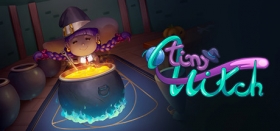
Tiny Witch Review
It’s the season for witchy games, and so Tiny Witch was the game to play.
In Tiny Witch, you play as Sophie, a witch who can’t speak but was given the power to make potions and open her own shop by a talking cat. As you run your shop, you open a small little place in the village where you have ten days to make a profit and please the many dungeon lords in the local area.

Naturally, it’s all about multi-tasking, and as someone who has worked in retail? Well, it’s all about customer service and following the recipe. In the village, you have five recipes to learn over the next ten days: Spirits, Zombies, Skeletons, Ghouls, and Pumpkin Heads. To make these, you need a specific type of pestle and your handy cauldrons. You need to use mushrooms to make spirit fragments, which you then need to put in a pestle to combine with other spirit fragments to make the Dungeon Lords’ little familiars.
Of course, you also need to consider that there are different types of customers. You’ll find that there are your average customers, impatient ones, and the dubiously wealthy. With most customers, you’ll find that you can extend their patience bar by apologising to them, but this won’t work with your impatient customers. The only way to keep them happy is to make your items quickly or find some upgrades such as decorations and pets to keep them happy. If they aren’t, you may find yourself attacked, which will slow down your progress.

You can buy items by making more of a profit than simply breaking even. Don’t worry about breaking even in the day too much, as there’s no time to rest. No one needs to sleep when there are Dungeon Lords that need new familiars to battle adventurers.
When playing Tiny Witch, it can be a challenge to get to your cauldrons and pestles. But it’s not so straightforward as simply dodging customer attacks. Occasionally, your roof will leak, and then you have to avoid spillages or get your broom and sweep up the mess. It makes sense that the developers — Creative Hand, would recommend you use a controller instead of a keyboard and mouse.
Once you’ve done ten days at one shop, you can move location. Each area has a different selection of items for you to make, and you start from scratch to make them. You need to use your head a bit to ensure you keep track of any angry customers and spillages or even poisonous mushrooms in your way. Upon entering a new area, you basically start from scratch. There aren’t any additional items, so you need to make a profit to ensure that you won’t have to repeat the day.

There are four areas in total in Tiny Witch: Village, Forest, Cave, and Desert. In each one, you need to make different familiars. The structure stays the same for all of them, and the goal is to earn the most gold in each round. Overall, it’s not a difficult game. It’s just a matter of learning timing and understanding where you should place each cauldron and pestle and which ingredients will require boosts.
While there isn’t much of a story to Tiny Witch, I have to admit it was a pretty fun game. Each level requires ten days of work, and you quickly get used to what you need to avoid and which ingredients require boosts. With the addition of pets and cleaning, it’s a fast-paced game that might not be the perfect stress reliever. I would compare it to Overcooked when I say my stress levels went up.
Tiny Witch (Reviewed on Windows)
This game is good, with a few negatives.
With cute graphics and fast-paced gameplay, I would recommend Tiny Witch to any fans of Overcooked who are looking for a game to focus on when they want to switch their brain off to the rest of the world.







COMMENTS